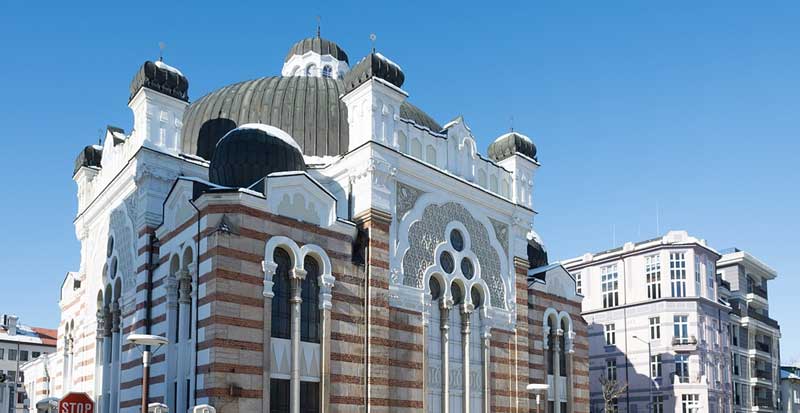
Resembling the old Moorish Leopolstadter Tempel, the largest synagogue of Vienna and described as the pride of the Bulgarian Jewish community, the Central Synagogue of Sofia, the capital city of Bulgaria, is the second largest Sephardic or Spanish-Jewish synagogue in Europe and the largest on the Balkan Peninsula.
Located right next to the Central Market Hall and designed by the Austrian architect Friedrich Gruenanger, the construction of the synagogue began on 13 November 1905, on the site of an old one, known as Ahava ve Chesed, and was officially opened on 9 September 1909, in the presence of Tsar Ferdinand I of Bulgaria.

The construction of the grand new synagogue was part of the reorganization efforts of the Bulgarian Jewish community under Ukraine-born Chief Rabbi Dr Marcus Ehrenpreis and president of the community Ezra Sol, along with the local leaders Ezra Tadjer and Avram Davidjon Levy. The Synagogue is also a part of the so called Square of Tolerance, which houses the Banya Bash Mosque, just around 197 feet (60 m) away from the synagogue, St Joseph Catholic Cathedral, 984 feet (300 m) away, as well as St Nedelya Orthodox Church, about 1640 feet (500 m) away. Thus, Sofia exhibits a unique example to the world as to how all major religions can co-exist and tolerate each other.
Banya stands for a bath and the Banya Bash Mosque was named after a big public bath building, which was initially a part of the mosque. However, although the building of the public bath still stands, it does not function anymore. While the St Joseph Catholic Cathedral was completely destroyed by the American bombing of Sofia during WW II and reconstructed only recently, the St Nedelya Orthodox Church was blown in an assault by the Communist Party in 1925 and was restored to its modern appearance between the summer of 1927 and the spring of 1933.

The building of the Central Synagogue of Sofia, followed by a large courtyard, was constructed according to a rectangular plan and the main premise has a diameter of 65 feet (20 m) and is about 102 feet (31 m) high, topped by an octagonal dome. The main sanctuary is octagonal, with four semi-domes at the pointed corners and with rectangular spaces between them, separated from the sanctuary with arches that serve as props of the female ward. The interior of the Central Synagogue of Sofia is richly decorated with columns made of Carrara marble, multicoloured Venetian mosaics, as well as aesthetically decorative wood carvings. While the altar is on a white marble pedestal, surrounded by exquisite handrails, the main prayer room, located just below an octagonal dome, is equipped with 1170 seats, made of Slavonian oak from the forests of Serbia.
The octagonal dome, painted to symbolize the heavens, contains a huge brass chandelier, weighing over 1700 kg, which was imported from Vienna. There are around 400 six-star stars on its periphery and there is a smaller chandelier in the centre and a circle of lamps around it.

During the Second World War, Sofia and other cities of Bulgaria were bombed and on 13 April 1944, a bomb fell in the northeastern corner of the Synagogue. Although it did not explode, the corner sustained some damage due to the consequent vibrations and the beautiful coloured stained glass windows were also broken. The bombings also destroyed the famous Judaica library, when most of the valuable Hebrew books were burned. However, the former glory of the building was subsequently restored by a very generous donation from the Doron Foundation of Israel.

During the period of socialism in 1982, the Minister of Culture planned to transform the Synagogue into a concert hall, but they were forced to discard the idea, due to the vehement and courageous protest of the leaders of the synagogue. However, as the Jewish community in Sofia has become small today, due to the mass immigration of the Jews to Israel and the secularity of the local Jewish population, regular services are now conducted in a small prayer room, to the right of the entrance. The big salon, equipped with about 400 seats, the left half reserved for women and the right one for men, is now used to carry out Theologies, only during the great Jewish feasts and events. In addition, the synagogue houses the offices of the Jewish Religious Council on the second floor.

Since 8 May 1992, the Central Synagogue of Sofia also houses the Jewish Museum of History, which includes the history of Jewish Communities in Bulgaria, the Holocaust and the Rescue of the Jews in Bulgaria expositions. A souvenir shop is also in operation. The synagogue was declared a cultural monument of national importance in 1956.